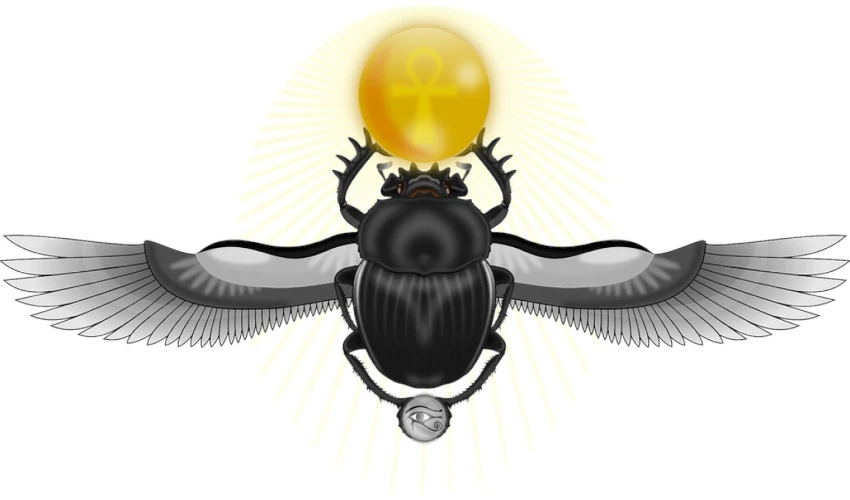In Hollywood movies, scarabs are depicted in ancient Egyptian Pyramids, tombs, and burial grounds eating humans and pouring out from poorly wrapped mummies. This makes for good TV drama, but scarabs don’t actually eat humans.
However, scarabs did play a pivotal role in ancient Egyptian culture and have long been associated with deep symbolic meaning in multiple cultures including ancient China.
Known as a sign of royalty, protection, and resurrection in Ancient Egypt, the scarab beetle represented a similar concept of ‘new life’ in Ancient China.
In this article, we’ll explore the history, origin, symbolism, and meanings behind the famous scarab beetle. Why was the scarab worshiped, and what can we learn today from what ancients knew in the past?
Let’s Dive In.
History And Origin Of The Scarab Symbol.
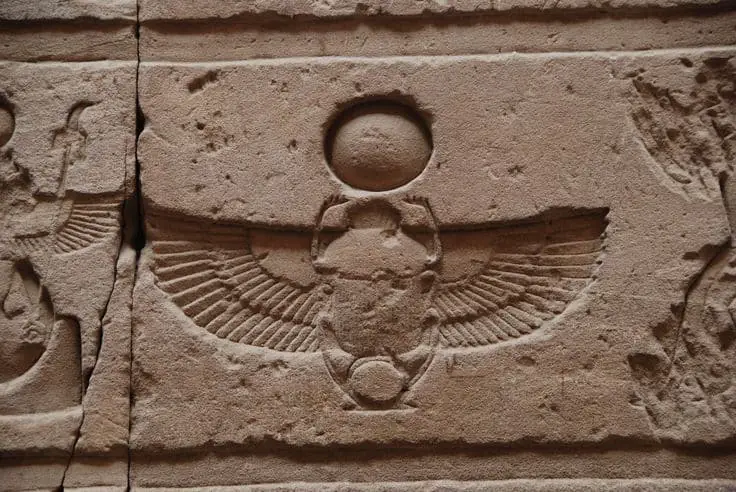
To understand the scarab, you have to understand the dung beetle which the scarab is named after. The name scarab’s came about as all the species of the dung beetle belong to the family Scarabaeoidea. Thus, scarab for short.
The female dung beetle lays her eggs in her perfectly rolled dung ball which she then buries underground. Her offspring then feed off the dung ball and reappear from underground.
This symbolic ‘emergence from the underground’ is one of the main reasons why ancients worshiped the dung beetle.
Egyptian Scarabs Are Modeled After The Dung Beetle
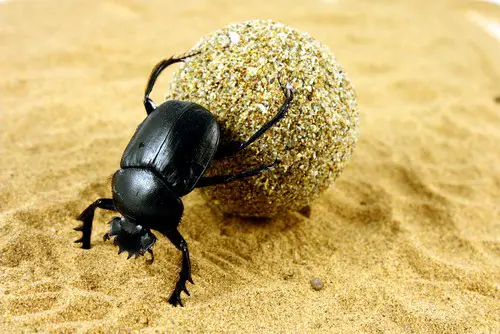
Ancient Egyptians associated the dung beetle with the god of the early morning sun, Khepri, whose name was written with the scarab hieroglyph. Khepri was believed to roll the ‘disk of the morning sun’ over the eastern horizon at daybreak, just like the dung beetle would roll his sphere from sun rise to sunset.
The Dung Beetle Symbolism in Ancient China
The Egyptians weren’t the only ones that held Scarabs in high regard. In Ancient China scarabs were worshiped, considered sacred, and strongly associated with other religious symbols.
According to locals, dung beetles are part of a potent an ancient Chinese traditional medicine to help treat diseases like dysentery and diarrhea. The Chinese medicine men would roast dung beetles and give them to the sickly to drink to treat stomachs.
Dung beetles are still essential components of Chinese folk medicine in modern China, helping to fight a variety of ailments.
Scarabs And Egyptian Gods
The scarab symbol might be beautiful when it’s on top of a crown, but despite their dirty job, dung beetles are equally beautiful in nature.
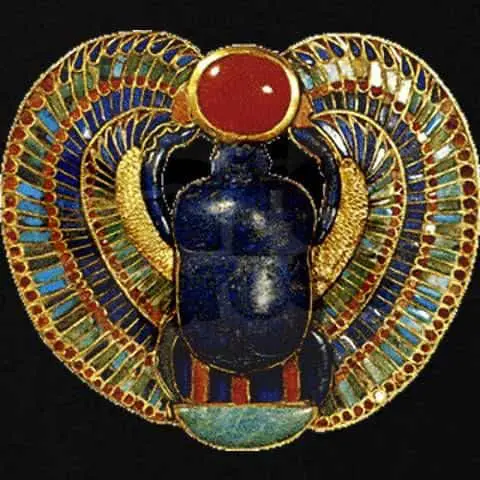
1. Scarabs Association With Khepri
Ancient Egyptians found scarabs so intriguing, they used the scarab symbol when spelling the name of their gods. The way the beetles rolled from sun up to sun down was seen as a metaphor of the birth of Khepri, a sun god who was often seen represented with a human body and a scarab-shaped head.
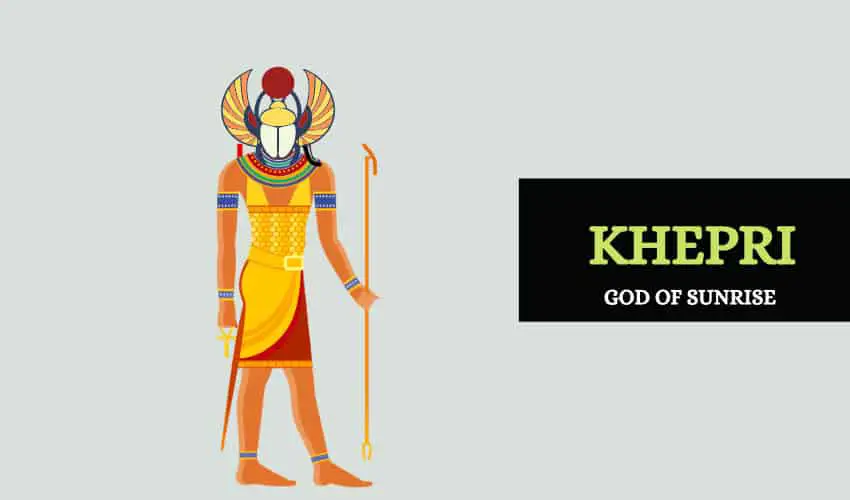
According to the Egyptians, the god, Khepri, rose into the sky every morning from nothingness. He invented himself anew everyday.
2. Scarabs Association With Atum
Atum, the Lord of the universe and the source of all creation, was another cosmic deity linked to the scarab.
Dung beetles hatched their eggs and created life out of nothingness . A vibrant new creation of young scarab beetles emerged, embodying the idea of spontaneous creation, something that only the god Atum could do.
3. Scarabs Association With Re
Egyptologists suggest that thousands of years ago, sacred scarab beetles embodied the Egyptian sun god Ra, who was the national god and the ultimate manifestation of the sun god.
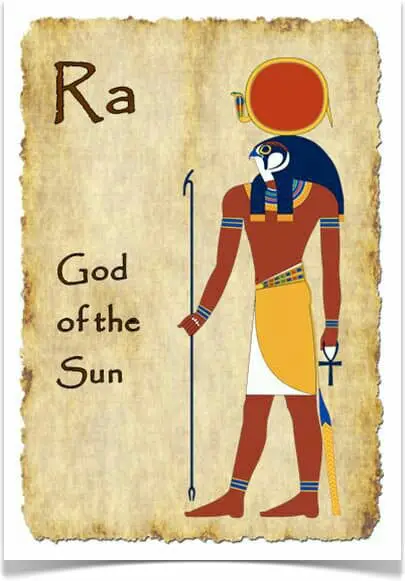
As the primary sun god, Re (or Ra) was responsible for the sun’s movement across the sky. According to the Egyptians, Ra “carried the sun” across the sky from east to west daily.
Ra pushing the sun across the sky was one of the reasons the locals associated the scarab with him. It appeared similar to observing a scarab beetle snowballing dung mounds on the ground until it reached the nest.
Ra was the beetle, and the rolling dung ball symbolized the sun.
4. The Egyptian Beetle God
The scarab beetle was sacred, divine, and special to ancient Egyptians. This critter was linked to the creation stories and had connections to the Egyptian gods, especially Khepri, the Egyptian “beetle” god.
It also connected with the god Atum and Ra, the most potent Egyptian god. Seemingly, the antennae on the scarab’s head were similar to the uraeus ( a solar disk surrounded by cobras)- a symbol only worn by powerful deities!
What Does The Scarab Symbolize?
Ancient Egyptians held scarabs in almost godlike status. They likened them to particular gods and worshipped them because the insects revealed so much about the universe and the spirit world to the Egyptians.
They believed that the deep symbolism scarabs carried with them gave clarity and revealed a way for people to navigate through life.
What else did scarabs symbolize?
Symbolic (and spiritual) Meanings of the Scarab Beetle
1. A Symbol Of Renewal And Rebirth
The scarab beetle was a manifestation of Ra, the sun god. Just like scarab bugs that sprang out of dead matter, the sun god Ra rolled the sun across the sky during the day, where it would set into the abyss and rise in the morning (rebirth) to shine again (renewal of life).
2. Representation Of Rising From Nothingness
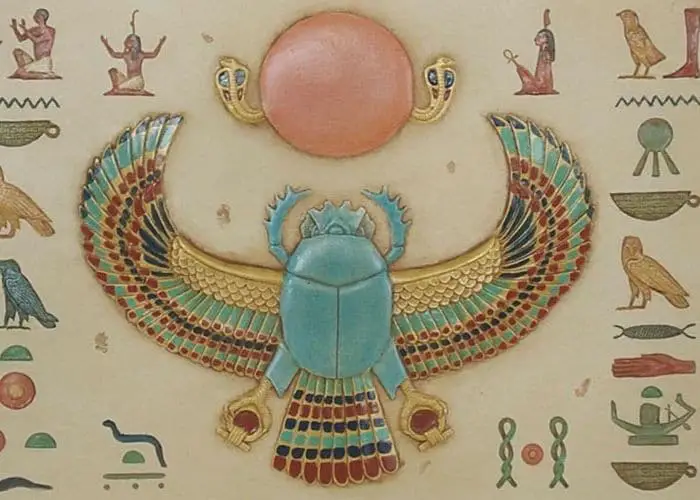
A dung beetle lays eggs in mounds of waste where new beetles crawl out and still thrive. Through this observation, ancient Egyptians linked the beetles to Khepri, the self-creating god of the rising sun.
They believed that Khepri rose every morning as the sun out of ‘nowhere’ just like the beetles found new life after rising from filth.
3. The Never-Ending Life Cycle
Scarabs fed, laid their eggs, and hatched young ones within dung piles—their entire existence revolving around dirt.
These bugs repeated the cycle over and over, regenerating, continuing their species, and the old even dying in the dung. They embodied birth, life, and death, the never-ending life cycle.
4. It Means A New Beginning
Egyptians couldn’t help but notice that dung beetles were constantly transforming. They seemed productive, always discovering fresh poo, finding their way through pushing the heaviest and darkest matter to suitable locations without much struggle.
The scarabs appeared to portray their ability to survive, adapt, transform, surrender to change, and start over!
5. Life After Death
Similarly, scarabs epitomized the belief that there was life beyond the grave. The dung beetle’s nature of emerging from animal waste, which in this case equated to death, appears to have fueled this belief.
6. Immortality
Another reason ancient Egyptians venerated scarab beetles because they were symbols of immortality. The bugs laid eggs in what symbolized death, but new beetles still emerged. This pointed to a sign of new life, which was key to immortality.
7. Resurrection
The solar deity Khepri setting every evening and rising again at dawn was akin to the beetles burying dung balls in the ground from which live young beetles sprawled, symbolizing resurrection.
8. Protection
Jewelry and scarab-shaped accessories have been worn worldwide for ages, believed to harness Khepri’s protective powers. Egyptian locals thought these small magical objects warded off evil and ushered in good luck for the wearer in their current life and even the next.
Scarabs also protected the dead in ancient Egypt. Mummies were buried with protective scarab amulets to provide them with a safe transition into the afterlife.
9. Symbol Of Wealth
Egyptians saw the scarab beetle as an attractor of wealth and good fortune back in time. Their wit, industry, intelligence, and devotion to rolling dung linked them to success. Although slow in nature, they represented everything necessary for material gains.
Egyptians also viewed this insect as a lucky charm, and that’s why anyone who desired wealth and success wore the scarab amulet, including the Pharaohs.
10. Inner Strength
Scarabs mirrored strength for Egyptians. The locals mellowed at the insect’s indomitable spirit, admirable skills, and diligence they demonstrated while dragging dung balls almost 50 times its body weight. In fact, male scarabs can pull up to 1,141 times their body weight.
They acted as living reminders that anyone can cultivate dung beetle-like internal strength and handle anything life throws at you.
The Symbolic Meaning of a Dead Scarab Beetle
Scarabs were symbols of all things beautiful—from wealth, luck, immortality, and new beginnings. But, a dead scarab beetle represented misfortune.
It meant that one was exposed to evil entities and was vulnerable to harm and bad luck. Egyptians needed to repair their weakened defenses by purifying their chakra, meditating, and wearing protective amulets.
Finding dead scarab beetles was also a sign of caution that one had lost focus. It served as a wake-up call for those that might have given up their dreams.
The Winged Scarab Meaning
Some scarab beetle symbols featured wings. These wings were attached to the scarabs manually and were actually from a different creature, typically a bird.
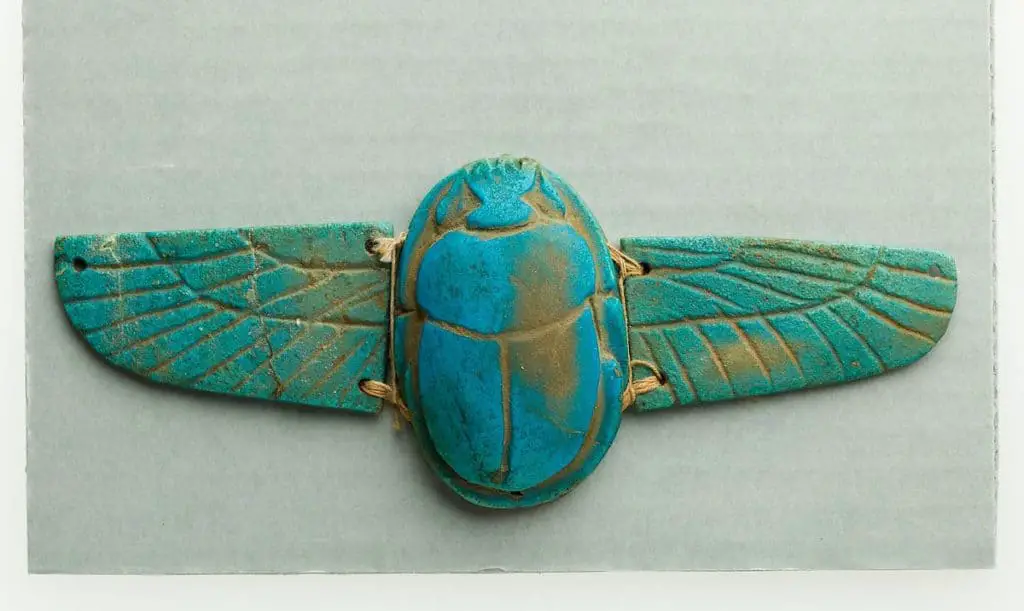
According to the Egyptians, the wings acted as an additional connector to the god Khepri, often portrayed with bird wings. Connecting to the sun god Khepri guaranteed rebirth for the dead and assured them of smooth flight to the otherworld. Winged scarabs were also a great way to adopt the winged scarab into the previously popular Egyptian Ankh symbol.
The Scarab Beetle And Egyptian Mummification
Ancient Egypt believed in the afterlife and held unmatched funerary rites for this.
The dead had to harness the resurrection, regeneration, and immortal powers the scarab represented if they wanted a peaceful transition to the afterlife.
So, how were the mummies supposed to harness these powers?
Scarab amulets. There was a reserved role for scarab amulets in a mummy’s transition to the spirit world.
Egyptians buried the mummies with beetle amulets made of unique stones. An article from the University of Birmingham states that heart scarabs were sewn on wrappings and placed over the heart, chest, or throat of a body mummified body.
Since the heart was the seat of a human’s memory, emotion, and intelligence, ancient Egyptians believed it was usually weighed for purity in the afterlife by the god Anubis, the son of Osiris and ruler of the dead.
Placed on the mummy was a heart scarab amulet with inscriptions from the Book of the Dead, pleading with the heart not to betray the deceased on judgment day.
Also, as a symbol of rebirth and new beginnings, a scarab amulet was believed to magically invoke protection for the dead owner, perhaps from the young sun god Khepri.
Scarab Beetle FAQ:
Are Scarabs Real Bugs ?
Scarabs are the most common types of beetles and are classified under insects (or bugs). The sacred scarab, or the dung beetle, is the most famous.
Do Scarabs Eat Human Flesh ?
Egyptian beetles will not eat your flesh! Hollywood blockbuster films created a delusion that scarabs are evil bugs that predate humans.
As it turns out, however, scarabs do not eat human flesh. Their food sources are balls of dung that they reserve for themselves from another animal’s excrement.
What is a Scaraboid?
A scaraboid is a scarab amulet used as seals on letters, official documents, bags, and jars in ancient Egypt. Scaraboid seals came in various sizes and designs. Even though they took a scarab shape, they didn’t feature the beetle’s anatomy or imitate its appearance.
Are Scarabs Dangerous?
Scarabs may look quite intimidating, but they are docile insects that don’t really harm humans, contrary to what “The Mummy” movie portrays. These insects have been utterly helpful in shaping Egypt’s traditional cultures and beliefs and conventional Chinese medication.
They are also universally beneficial to the ecosystem as they play a vital role in garden clean-ups, nutrient recycling, and revitalizing soil structure.
Final Thoughts: Meaning and Symbolism of The Scarab
When ancient Egyptians saw scarab beetles, they saw a beetle equivalent to a god. Scarab beetles were stamps of nobility for this society, an emblem of eternal life, regeneration, good fortune, protection, renewal, and rebirth.
So, here’s a little challenge: the next time you see a scarab, don’t just see the dung it carries. Try to see the message it could be portraying. It could be a reminder that you need to lift your perspective, roll with transformation, or make something positive out of your life.
If a scarab beetle symbol has been showing up in your life more often lately, or if you desire a beetle tattoo, jewelry, or painting, we hope the article guides you to decipher the symbolic meaning it carries.
You Might Also Want to Check Out What The Eye of Horus Really Represents.
Check Out Our Other Interesting Articles About Ancient Egypt…
- The Ankh (unk) Symbol: Ancient Egyptian Meaning
- How Old Are The Pyramids in Egypt? The Science
- How Old Is The Great Sphinx of Giza ? New Evidence
- What Is The Egyptian Eye Of Ra ? Symbolism Explained
- The Eye of Horus vs. The Eye of Ra | Meaning
- Did Ancient Civilizations Use Psychedelics? You Bet They Did !
- Scarab Beetle Symbolic Meaning | History & Origin
Loved what you read?
Hit that share button and let the world in on the secret – we’d be thrilled!
Got thoughts? We’re all ears for your feedback, corrections, or a good old chat. Don’t be shy; drop us a line.
And hey, don’t miss out on our curated list of must-reads in the recommended books section.
Big thanks for diving in with us today!


